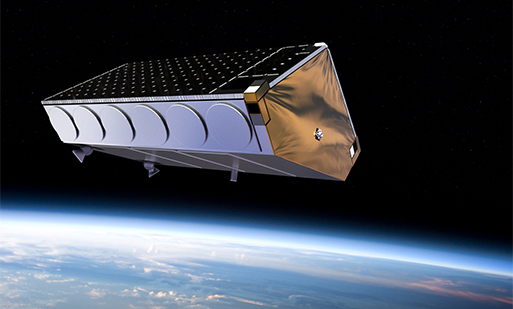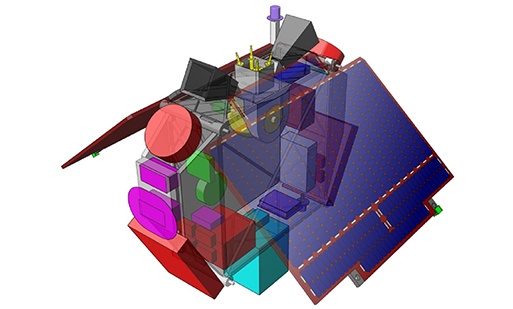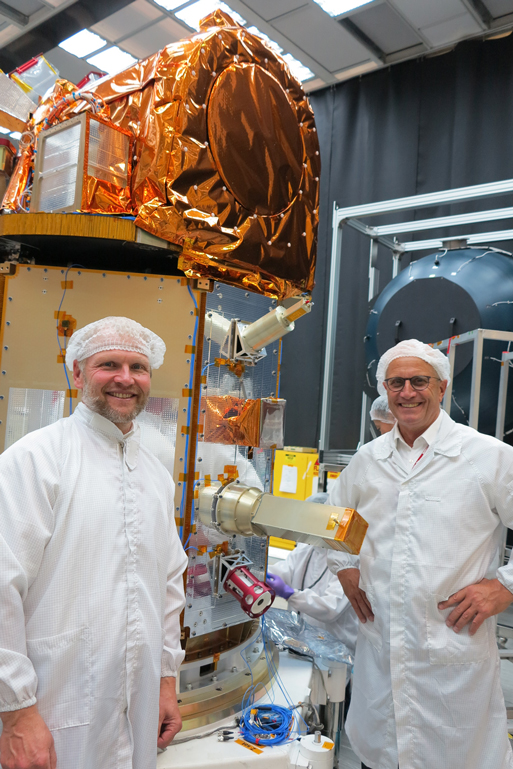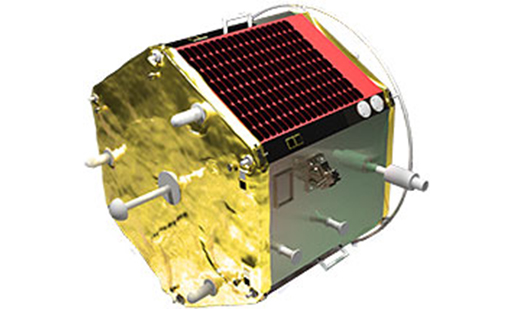SpaceTech’s engagement in space missions
Many SpaceTech employees look back on more than two decades in the space business, having been involved in numerous space missions as responsible managers and engineers. As a natural continuation, SpaceTech has engaged in space missions and related spacecraft design since its very beginnings.
The focus of our space development activities is primarily in the areas of applied science and earth observation with small satellite systems.
- System management and engineering
- System and subsystem design
- Equipment specification and procurement
- System level assembly, integration and test
- Launch preparation and in-orbit commissioning
Space missions - Projects and milestones

SpaceTech has developed a constellation of LEO satellites, allowing for global access to sensor data for IoT/M2M applications.
M2Space aim
The aim of the M2Space Initiative is to extend the reach of terrestrial networks also to the remote corners of our planet - to make M2M communication truly global - at an attractive price and with (almost) the same ground devices as used by terrestrial M2M service providers.

SpaceTech's approach for a robust and reliable satellite platform has been worked out in the 'Multi Purpose Small Platform' (MPSP) project.
Key elements of the MPSP 'FlexSat' concept
- Open satellite architecture with flexible platform configuration
- Modular electrical architecture
- Mission specific structure, power and thermal design
- Robust, consequent one-failure tolerant design
- Flat team hierarchy and intensive customer interface
- Cost efficient development logic and a consequent customer oriented design

The ARGO / FormoSat-5 program with the National Space Agency of Taiwan (NSPO) was one of the first large SpaceTech satellite contracts.
In 2005 SpaceTech, in cooperation with Carlo Gavazzi Space (CGS) in Milan, Italy, won the contract for the Taiwanese ARGO mission against strong international competition. After the procurement of two earth observation satellites FormoSat-1 and FormoSat-2 from abroad, the Taiwanese National Space Organisation (NSPO) as the customer intended ARGO to be the first satellite to be designed and developed in Taiwan.
SpaceTech and Carlo Gavazzi Space signed responsible for:
- Satellite system engineering support to NSPO
- Hardware development support to NSPO and domestic industry
- World-wide procurement of the major portion of the satellite hardware
Furthermore, SpaceTech manufactured essential equipment for FormoSat-5:
- Solar arrays
- Sun sensors
- Satellite structure
FormoSat-5 has been successfully launched on the 24th of August 2017. This is a major milestone both, for NSPO as being the first earth observation satellite being designed by Taiwan and for STI on its way to be a small satellite system provider.
Links
ARGO paper model

As the overall mission and system prime SpaceTech established a technological baseline both, in terms of mission implementation and satellite design, for the first German servicing mission DEOS.
Main goals of the DEOS mission
rendezvous with and berthing of a non-cooperative and tumbling spacecraft by means of a manipulator system accommodated on a servicing satellite
docking of the spacecraft via a dedicated docking device
servicing tasks in the coupled configuration as well as the controlled de-orbiting / re-entry of the spacecraft’s coupled configuration in the earth’s atmosphere at the end of the mission
DEOS concept
In a Phase A contract to the German Aerospace Center DLR and leading a team of German small enterprises and university institutes, SpaceTech demonstrated the feasibility of the mission by establishing a concept for the different flight manoeuvres, including far and close range rendezvous as well as fly-around manoeuvres, by defining a realistic experiment program for the one year mission under consideration of environmental conditions and by providing an initial spacecraft design for the servicing as well as the client spacecraft.
SpaceTech development of DEOS client spacecraft
In the Phase B, again in a direct contract to DLR, SpaceTech was responsible for the development of the DEOS client spacecraft. Furthermore, in subcontracts to OHB System and Kayser-Threde, SpaceTech was responsible for the launcher, the berthing / docking mechanism and the software of the automation and robotics instrument control unit.
Links
DEOS paper model
DEOS Phase A datasheet
DEOS automation and robotics payload
DEOS Phase B overview

Phases 0 and A studies for the Lunar Exploration Orbiter (LEO) program have been initiated by the German Aerospace Center in order to broaden the knowledge of the moon's surface and immediate space environment.
LEO mission concept
The overall mission concept established during the study phases consisted of a main spacecraft, accommodating optical, radar and infra-red moon observation instruments and providing passage from earth to the final moon orbit for two twin spacecraft.
After separation from the mother spacecraft the two twin satellites span a constellation on a near polar, low altitude moon orbit optimized for their specific mission purpose.
SpaceTech design for LEO
- Twin spacecraft
- Coordination and accommodation of the three related scientific payloads
- Lunar Precise Range and Range Rate (PRARE-L) instrument for the recovery of the gravity field via continuous Ka-band ranging based measurement of the relative distance between the two satellites
- Lunar Magnetometer (LunarMag) with a set of two locally separated magnetometers in a quiet spot at the end of a deployed boom on each spacecraft providing for excellent magnetic measurements with unprecedented spatial and temporal resolution
- Radiation Pressure Sensor (RaPS) measuring the remnant radiation induced forces acting on the spacecraft in the low lunar orbit
Links
LEO overview
The Sentinel-5 Precursor satellite system (S5P) is a scientific operational earth observation satellite in the framework of the GMES (Global Monitoring for Environment and Security). The satellite provides atmospheric chemistry data of the troposphere. The measurements are performed in a high temporal and spatial resolution with global daily coverage.
SpaceTech S5P system study
OHB/SpaceTech defined the satellite design requirements and the accommodation details of the payload in a Phase A/B1 system study.
In this study, SpaceTech signed responsible for the configuration design of the spacecraft, including the structural / thermal sizing, the dimensioning of the electrical power system, the definition of the harness and the design of the Mechanical Ground Support Equipment. In the system team with OHB, SpaceTech was responsible for the TROPOMI Payload ICD, the system budgets and the support specifications for environmental design and test, alignment requirements and EMC.
The Sentinel-5 Precursor spacecraft platform is a heritage-based single-failure-tolerant platform for Low-Earth-Orbit observation satellites with 3-axis-stabilized attitude and orbit control, high data storage capacity and X-band data downlink.


